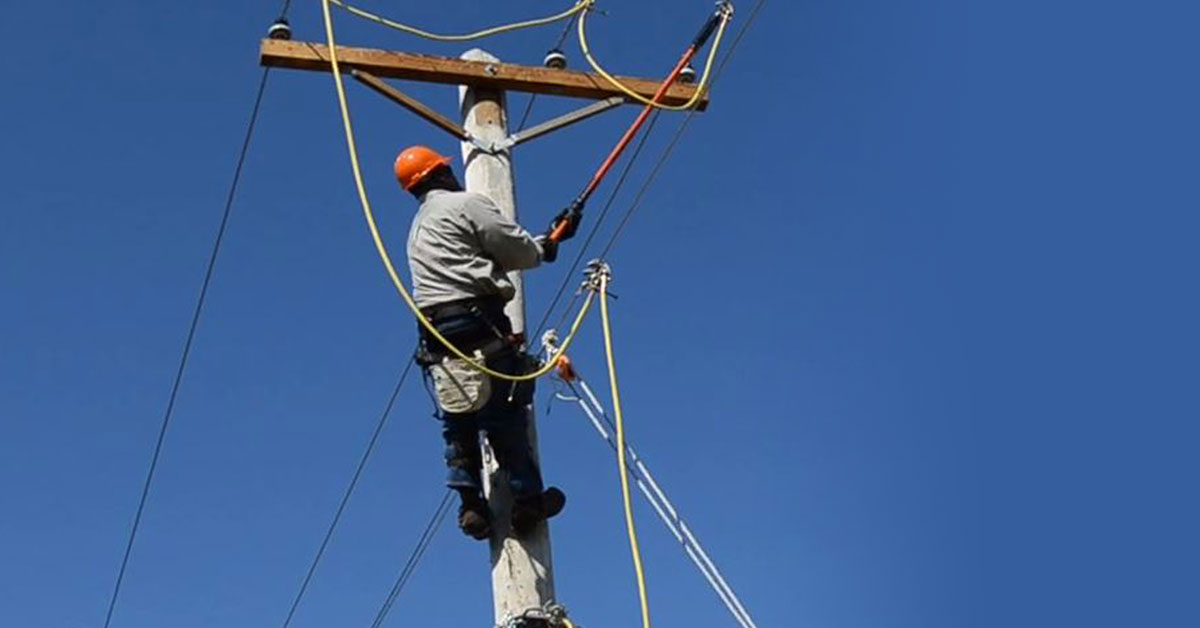During line work, it is commonplace for lines to be de-energized and grounded for worker protection in the event there is a fault current, which could be due to a variety of issues. In this blog, we will look at some common misconceptions about temporary personal protective grounding.
Current will take all paths to ground. The current divides inversely proportional to the resistance of the various paths. In the case of a 10kA fault, if the parallel path ground set has a resistance of 1Ω and the line worker has a resistance of 1,000Ω, the ground set will see 9,999A of current while the line worker sees 1A. As shown in this example, the line worker always sees some current, even though most of the current passes through the parallel path ground set. 2. If I use a 4/0 ground set, I will be protected regardless of the fault current.
2. If I use a 4/0 ground set, I will be protected regardless of the fault current.
Several pieces of information are required to select the correct grounding equipment. The information includes the maximum available fault current at the worksite, the X/R value and the duration of the fault. All this information helps in determining the proper Grade and rating of the ground set per Tables 1 and 2 of ASTM F855. CHANCE® provides a variety of grounding equipment that meets these ratings.
3. If I use Grade 5 ground clamps, then I have a set rated for Grade 5.
All ground sets are rated to their lowest-rated component. Like the weakest link in a chain determines the strength. If you are using Grade 5 clamps with #2 cable, the set is limited to a Grade 1 rating because the #2 cable is limited to Grade 1 in Table 1 of ASTM F855.
4. I can put the bare ends of my grounding cable in my plain-plug ground clamps and make a rated grounding set.
To have a properly assembled ground set per ASTM F855, it is required that ferrules be crimped onto the ends of the grounding cable. The preferred option for ferrules is a shrouded ferrule with heat shrink. This helps block moisture and contamination and provides strain relief on the cable to ferrule connection. CHANCE® provides a variety of ferrules for temporary protective ground sets.
5. Grounds placed between a worker and opening points act as barricades, blocking any current rise or current flow at the worker's location.
As previously discussed, current will take all paths to ground, inversely proportional to the resistance of that path. Therefore, even on the best-grounded line, the line worker is subjected to some current in the event of a fault. Grounds are not a brick wall. The best way to protect the worker is to create an equipotential zone (EPZ) using a combination of grounding and bonding. Additionally, electricity travels 3,105 miles/cycle, making any protection device limited on time to react before the worker experiences the fault.
6. Inductive voltages build up over time, therefore, grounds can sometimes be removed by hand.
Induction is an ever-present danger and can be controlled, but not eliminated. Induction has been attributed to several injuries and fatalities on worksites in the past. Grounds should never be installed or removed by hand.
Per OSHA 1910.269(n)(6) ”Connecting and removing grounds.”
1910.269(n)(6)(i)
The employer shall ensure that, when an employee attaches a ground to a line or to equipment, the employee attaches the ground-end connection first and then attaches the other end by means of a live-line tool. For lines or equipment operating at 600 volts or less, the employer may permit the employee to use insulating equipment other than a live-line tool if the employer ensures that the line or equipment is not energized at the time the ground is connected or if the employer can demonstrate that each employee is protected from hazards that may develop if the line or equipment is energized.
1910.269(n)(6)(ii)
The employer shall ensure that, when an employee removes a ground, the employee removes the grounding device from the line or equipment using a live-line tool before he or she removes the ground-end connection. For lines or equipment operating at 600 volts or less, the employer may permit the employee to use insulating equipment other than a live-line tool if the employer ensures that the line or equipment is not energized at the time the ground is disconnected or if the employer can demonstrate that each employee is protected from hazards that may develop if the line or equipment is energized.”
Summary
Temporary personal protective grounding can be a tricky situation to get correct. See more grounding resources and get the Encyclopedia of Grounding to boost your knowledge.
The purpose of this blog is to help clarify some of the common misconceptions surrounding temporary personal protective grounding and keep line workers safe on the job. Always follow your company’s work practices and procedures.
For additional questions or to schedule training with a CHANCE® expert on temporary personal protective grounding, or a variety of other subjects, please reach out to your local Hubbell Utility Solutions’ Territory Manager or by filling out this form.

